#mixed-use project estimate
Explore tagged Tumblr posts
Text
Why a Commercial Estimating Service Is Essential for Mixed-Use Development Projects
Mixed-use development projects combine residential, commercial, hospitality, and sometimes institutional or cultural spaces into a single cohesive plan. While these projects offer vibrant, multi-functional communities and increased land-use efficiency, they also come with high complexity in both design and budgeting. A commercial estimating service is essential in navigating this complexity, helping stakeholders control costs, balance program requirements, and streamline planning from preconstruction through completion.
Understanding the Complexity of Mixed-Use Projects
Unlike single-purpose developments, mixed-use projects demand coordination between multiple functions—each with its own codes, building systems, and operational needs. Residential units may require soundproofing, individual HVAC units, and different egress requirements compared to commercial spaces. Retail tenants often have unique build-out requirements. Hospitality components may call for luxury finishes and complex mechanical systems.
A commercial estimating service brings structure to this multifaceted picture. Estimators break down the development into clearly defined zones, identify distinct cost drivers within each use, and prepare segmented estimates that allow developers to see how each component affects the total project cost.
Supporting Phased Construction and Cash Flow Planning
Mixed-use projects are often developed in phases due to financing, permitting, or logistical constraints. For instance, a developer may prioritize the retail podium and parking garage before proceeding with upper-level residential or hotel components.
Commercial estimating services support phased planning by producing detailed construction cost breakdowns by stage. This allows developers to align funding disbursements with construction sequencing and helps financial institutions assess risk based on projected cash flow needs.
Accounting for Shared Infrastructure
Mixed-use buildings typically rely on shared infrastructure—such as common mechanical rooms, centralized elevators, or joint-use amenities like lobbies, fitness centers, and parking structures. Allocating the costs of these shared systems accurately across the different uses is vital for budgeting, accounting, and financing.
Estimators evaluate how shared systems are used across program types and assign costs proportionally. This is especially important when different ownership structures are involved, such as when retail is held by one entity and residential by another.
Navigating Diverse Code Requirements
Each use within a mixed-use building is subject to specific building codes, occupancy classifications, fire safety standards, and ADA accessibility mandates. For example, a restaurant tenant may require commercial-grade ventilation and fire suppression systems, while hotel units may need emergency power and elevator recall.
A commercial estimating service works closely with architects, engineers, and code consultants to ensure that these varied code requirements are identified and accurately priced. This avoids surprises during plan review and ensures the project remains compliant without triggering costly redesigns.
Managing Tenant Improvements and Flexibility
Retail and commercial tenants often negotiate for custom build-outs and improvements beyond base building construction. These can include upgraded flooring, lighting, storefronts, signage, and even plumbing or kitchen installations.
Estimators provide separate allowances or hard numbers for these improvements, depending on lease terms and tenant agreements. This ensures both landlords and tenants understand their financial responsibilities and can plan accordingly. Where flexibility is needed for future changes in occupancy, the estimating service can price adaptable infrastructure (e.g., movable walls or modular utility connections).
Supporting Financial Feasibility and Pro Forma Development
One of the most critical early tasks in a mixed-use development is determining whether the project “pencils out.” Estimators play a key role by feeding accurate, data-backed construction costs into financial models. This enables developers to calculate projected returns, identify financing gaps, and secure investment based on realistic cost assessments.
If preliminary costs exceed target budgets, the estimating service can assist in value engineering—offering options that reduce costs while preserving project quality and functionality.
Enabling Efficient Procurement and Scheduling
With multiple project components running in parallel, procurement needs to be strategically managed. Items such as curtain walls, elevators, and mechanical systems may serve multiple building areas and must be ordered with precise specifications and lead times.
A commercial estimating service helps map out procurement schedules by forecasting long-lead items and aligning order timelines with construction phases. This prevents bottlenecks and enables better coordination across trades and suppliers.
Enhancing Owner and Stakeholder Communication
Mixed-use projects often involve multiple stakeholders—municipalities, investors, joint-venture partners, anchor tenants, and future residents. A clear, structured cost estimate enhances communication by showing how funds will be spent and which portions of the project account for the greatest investment.
By offering segmented and visualized estimates, commercial estimating services make it easier for all parties to understand the financial scope of the project and build confidence in the development team’s planning capabilities.
Conclusion
The integrated nature of mixed-use developments presents both opportunity and complexity. A commercial estimating service serves as the financial compass that helps developers navigate this intricate landscape. From phased construction and shared infrastructure to diverse codes and tenant expectations, estimators bring clarity, precision, and adaptability to ensure these ambitious projects remain financially viable and strategically sound. In the world of mixed-use construction, accurate cost estimation isn’t just beneficial—it’s indispensable.
#commercial estimating service#mixed-use project estimate#residential and retail cost#hotel construction estimate#tenant improvement costs#phased development budgeting#shared system allocation#MEP estimating#occupancy code estimate#ADA compliance cost#construction cash flow#pro forma cost inputs#segmented cost analysis#cost breakdown by use#high-rise mixed use estimating#commercial tenant allowances#hospitality build-out costs#retail shell pricing#value engineering mixed-use#estimating for development feasibility#multi-zone construction costs#LEED estimating mixed use#parking garage cost#procurement timeline planning#long-lead item estimates#construction financing support#estimating shared amenities#mixed-use coordination cost#architectural budgeting support#developer financial modeling
0 notes
Text
"In Sacramento, California, an estimated 6,615 people are experiencing homelessness, a number that — while still heartbreakingly high — has declined 29% since 2023, according to the latest Point In Time counts.
But a new project, which has been in the works since 2022, might bring that number down even lower.
A new 13-acre property purchased by Sacramento County will soon be home to the Watt Service Center and Safe Stay.

The county broke ground on the mixed-use service center this week, which will provide shelter, emergency respite, safe parking, health services, and more to community members who are unsheltered — meaning they don’t have a place to safely sleep at night.
“We wanted to do something that is not only larger, but a large-scale campus to provide more than just the shelter,” Janna Haynes, of the county’s Department of Homeless Services and Housing, told KCRA3 News.
The Watt Service Center will have amenities to help meet the needs of anyone staying there, including bathrooms, showers, laundry, and food, as well as mental health, treatment, and employment services.
“You can also meet with your case manager, get behavior health services, look for a job, get rehousing services, a place for your dog,” Jaynes added. “It’s really everything you need, not only for your day-to-day life, but to hopefully end your homelessness.”
While the center is a costly offering, the city explained that it is ultimately less expensive than allowing the homelessness crisis to go unmitigated.
The land was purchased for $22 million and will cost an estimated $42 million to construct the center. According to ABC10 News it will be mostly funded by the American Rescue Plan Act.
While the center will have the capacity to host 225 beds in Safe Stay cabins, 50-person capacity in Safe Parking, and 75-person capacity for emergency/weather respite beds, it will serve countless others outside of the 350 total people it can house at any given time.
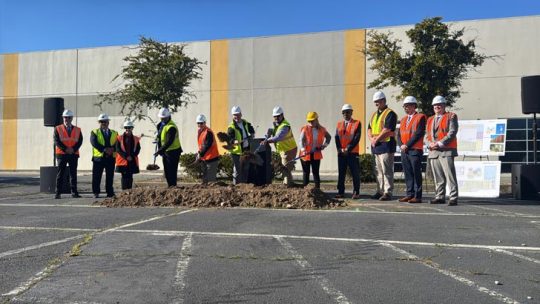
According to a press release from the county, “conservative estimates” have found that over the course of 15 years, the center will serve 18,000 people.
In 2017, the city found that the average cost for an “unsheltered individual” was about $45,000 a year, considering public systems like county jail, shelters, behavioral health, and more.
With the projected impact of the shelter, that cost lowers to less than $3,600 per person.
“If you break down the funding, it’s actually not that expensive,” Rich Desmond, county supervisor for District 3, told ABC10.
“It’s a heck of a lot cheaper than letting someone stay out in the community, unsheltered where they are extremely expensive in terms of the emergency response from fire, our emergency rooms, our law enforcement response.”
Providing what the county calls “wraparound services” not only brings down costs but truly helps people meet their basic needs.
“The really great thing about this site in particular, that we don't have at any other shelters, is the sheer size and the ability to really wrap everything people need,” Emily Halcon, director of the Department of Homeless Services and Housing with Sacramento County, told ABC10.
One notable feature is the center’s Safe Parking spaces, which are the first of their kind in the city. People living in their cars will now have a safe place to park, monitored by security.
“We know a lot of people who are unsheltered actually are living out of their cars,” Desmond said, “maybe a family that’s barely hanging on but they still need that vital transportation to get their kids to school or get to work.”
This support is especially helpful for those who are newly homeless, Halcon added, building on the amenities provided in the county’s two other “safe stay” facilities.
While Sacramento County just broke ground on the Watt Service Center, officials say they hope to begin moving people into the facility in January 2026.
“Our staff is putting in extra time and attention to this campus, ensuring that it houses everything we need to end homelessness for people,” Desmond said in a statement.
Once it’s up and running, Jaynes told KCRA3, they plan to onboard formerly unhoused community members as part of the staff at the facility.
“When you have a conversation with someone who understands where you’ve been, and you see the success they’re having now,” Jaynes said, “it really does give you hope something could be different.”
-via GoodGoodGood, January 24, 2025
11K notes
·
View notes
Text
Dandelion News - April 1-7
Like these weekly compilations? Tip me at $kaybarr1735 or check out my Dandelion Doodles! Last month’s Doodles are free to the public, so go take a look :D
1. Galapagos tortoises at Philadelphia Zoo become first-time parents at nearly 100

“Mommy, the female tortoise, is considered one of the most genetically valuable Galapagos tortoises in the Association of Zoos and Aquariums’ species survival plan. [… T]he zoo said it is “overjoyed” at the arrivals of the four hatchlings, a first in its more than 150-year history.”
2. Massachusetts home-electrification pilot could offer a national model

“In total, the program is providing free or heavily subsidized solar panels and heat pumps to 55 participating households, 12 of which also received batteries at no cost. […] It’s a strategy that program planners hope can help address the disproportionate energy burden felt by lower-income residents of the region[….]”
3. National Park Rangers rebel against queer erasure on Trans Day of Visibility

“[… A] group of over 1,000 off-duty, fired, and retired National Park Service employees launched Rangers Uncensored, an online archive that restores and amplifies LGBTQ+ stories quietly scrubbed from government websites since President Donald Trump’s second inauguration.”
4. World's largest wildlife crossing reaches critical milestone

“Over the next few days they'll be adding 6,000 cubic yards of specially manufactured soil to cover the crossing, a mix of sand, silt and clay inoculated with a bit of compost and hyperlocal mycorrhizal fungi, carefully designed and tested to mimic the biological makeup of native soils around the site.“
5. Bipartisan bill to boost green building materials glides through House

“[B]ipartisan legislation the House of Representatives passed in a 350-73 vote last week would give the Department of Energy a clear mandate to develop a full program to research, develop, and deploy clean versions of the building materials.”
6. Tribal Wildlife Grants Funding Announced
“Tribal Wildlife Grants are intended to help Tribes develop programs for the conservation of habitat and species of traditional or cultural importance[….] Typically funded projects include: conservation planning, fish and wildlife management and research, habitat mapping and restoration, inventory and monitoring, and habitat preservation. […] A total of $6.1 million is available for this round of funding[….]”
7. Germany adds another one million PV arrays to take solar total to 104 gigawatts
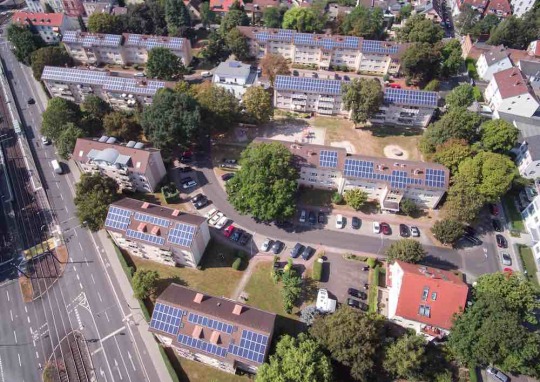
“Following a rapid rise in household solar panel installations, Germany’s total number of PV arrays has passed the five million “milestone[.…]” Solar systems already cover almost 15 percent of Germany’s electricity demand, BSW-Solar said. […] The total capacity of all PV systems installed in Germany surpassed 100 GW at the start of the year.”
8. Stronger together: Bilby conservation efforts enhanced by Indigenous knowledge

“Ms. Geyle said the results showed combining [conventional science and traditional tracking methods] more accurately estimated bilby abundance than using either technique individually[….] "[… ensuring] that Indigenous people remain central to decision-making about their lands and species that inhabit them," Ms. Geyle said.”
9. Lennar will build 1,500new Colorado homes with geothermal heat pumps

“The homebuilder is partnering with Dandelion Energy to install the tech, which is efficient but expensive — unless it’s built into new homes from the start. […] And by eliminating the need for new gas pipelines and reducing the peak electricity demands on the power grid, subdivisions built on this model could save a bundle on utilities as well[….]”
10. New strategy launched to protect Tanzanian biodiversity hotspot

“Conservationists have launched a 20-year-long project to protect what is arguably Tanzania’s most biologically rich landscape: the Udzungwa Mountains. The strategy places notable emphasis on communities living here, with more than half of its budget allocated to social and economic projects and managing human-wildlife conflict.”
March 22-28 news here | (all credit for images and written material can be found at the source linked; I don’t claim credit for anything but curating.)
#hopepunk#good news#nature#philadelphia#zoo#galapagos#tortoise#solar panels#clean energy#national park service#lgbt+#lgbt#lgbtq#park ranger#wildlife#us politics#ecology#green infrastructure#indigenous#habitat restoration#germany#solar energy#solar power#australia#geothermal#heat pump#energy efficiency#biodiversity#tanzania#animals
269 notes
·
View notes
Text

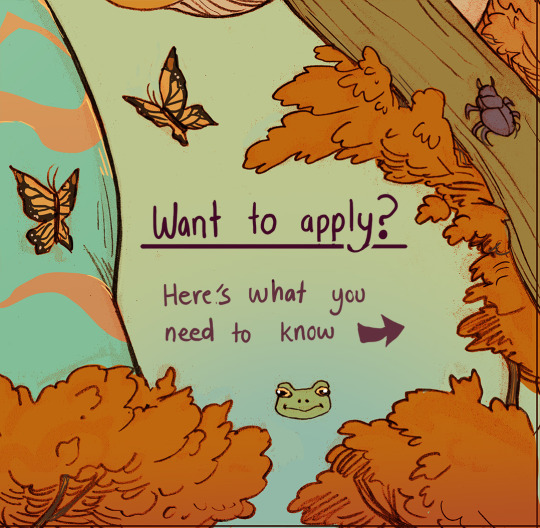



Butch Fairy Zine: Answering questions
What art style are we looking for? What is the estimated timeline? Will you get paid? we answer them here!
We will be answering more questions and posting them in the days leading up to the artist application form opening. So if you have questions, use our inbox, or you can fill in our interest form and leave them at the bottom. And if you have queries for the frog, you can leave them there too. He is very busy, so keep that in mind.
Find the interest form here.
Our Artist Application form will open on the 12th of January 2024.
text version under the cut
What type of artists are you looking for? And are you after a specific style or a range of styles?
We are looking for artists who can create pieces with fully rendered fairies and a background within the specified schedule. These can be digital artworks that are flat colour artworks, paintings, a mixture, or another style entirely.
We will also accept mixed media and traditional artworks, but they will need to be scanned at a minimum of 300dpi.
~
When you sign up for an artist position, are there any requirements to be a part of the team?
E-mail communication is required (discord is optional).
You must have a PayPal account to receive payment.
You must be able to communicate comfortably in English.
You must be 18 or older at the time of signing the contract by the 16th of February.
~
For artists accepted into the zine what would be the timeline for completing and submitting artwork?
Our current schedule for the artists requires concept ideas to be submitted by Feb 16th, and the final version by May 16th! Progress check-ins will be on Feb 29th, March 21st, and April 11th.
(In the image there is also a table including this information as well as the final submissions date being May 16th)
~
When the zine is for sale, where would the profits go to (charity, zine admin, etc.)?
We are aiming to hold pre-orders in June/July of 2024, with a flat fee paid to all contributors and additional proceeds split between contributors and mods.
Our priority is to make sure each contributor is paid fairly for their work. If sales do well enough, 20% will be used for future books and projects, and 80% split between taxes and fees, production costs, contributors and shipping costs.
~
Is this physical or digital and will there be prints of the art available? Got any merch ideas planned to go along with the zine?
Both physical and digital! Our goal is to make a 210 x 148 mm (A5) perfect-bound soft cover book.
We also plan to add some paper merch, including prints of some of the art from the book. Additional merch ideas include stickers, sticker sheets and bookmarks.
1K notes
·
View notes
Text

The Tumblr reblog sensation is returning. But like the Sayians or Shakespeare’s folios, it has the potential to develop in many forms.
Visit kamehamehamlet.com to be notified when we have more details.
Follow this blog for a peak behind the curtain.
And read on to learn more about the show, how we got here, and where we’re going.
Thank you for waiting just a little bit longer.
Revival Project FAQ
Who are you?
Hi! I’m Daniel Cole Mauleón (@writepictures), the writer of Kamehamehamlet. In 2015 I co-founded the theatre company Play-Dot Productions with KHH’s director Shalee Mae Cole Mauleón.
What is Kamehamehamlet?
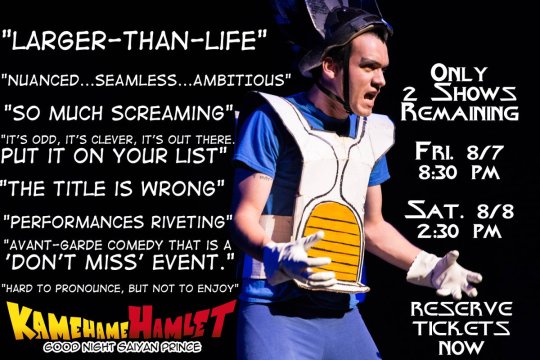
Kamehamehamlet: Good Night Saiyan Prince, was an hour-long one act play, performed during the 2015 Minnesota Fringe Festival. It’s a staged retelling of Vegeta and Freeza’s battle on the planet Namek. Marketed as a Dragon Ball Z and Hamlet mash-up, the parody quickly shuffled off its weighted gi, revealing it was actually a Waiting for Godot spoof. After five performances, Vegeta hung up his helmet of spiky hair. Seven years later, K (@amokslime) wrote this incredibly gracious post on Tumblr, which inspired two people to reach out to me via Reddit to ask if I had a script or a recording of the performance.
I want to pause the semi-marketing voice and say a heartfelt thanks to K. Kamehamehamlet was brought to life by an incredible team of artists during a summer I’ll never forget. We got laughs at jokes, gasps at fight choreography, and we broke even on the budget (a Fringe miracle TBH). K’s post gave me the chance to revisit that show through someone else’s eyes. The mix of pride and humility it stirs up is truly indescribable.
If there is art which has changed you, and especially if the artist is still alive I encourage you to non-intrusively share that with the artist.
Is there a copy of the script?
Yes, I’ll speak more about that at below.
Is there a recording of the performance?
There was, but I genuinely lost the files. And that’s for the best, honestly. It was a last-second attempt, filmed from two cheap cameras (with different qualities and resolutions!), both at bad angles and with truly awful audio. Trust me. It’s better this way.
That said, I do have other archival footage from rehearsal's, tech, etc. that I look forward to sharing for those curious.
What’s next?
This is the question I’ve been asking myself over the past year and the reason it took so long to post anything. Especially since one thing I want to do differently this time is make sure that any artists involved are meaningfully compensated for their time and skill. However, I can’t plan without a better estimate of what kind of support we would have, and I didn’t want to share our intentions without concrete details. Right now, the best way you can support this project is by signing up for the announcement on kamehamehamlet.com and following us on Tumblr and YouTube!
The second best thing you can do is to share with others about this project, if I’ve learned anything reading through the comments on K’s post, it is that there’s a much bigger audience for KHH than I could have ever imagined, and you likely know at least one more person who would be interested.
And while I don’t want to promise anything I can’t deliver on, I will share that I’m planning on making the script available this year and I’ll be writing a separate post about that in near future.
Update 5/21/24: We've announced a staged reading for later this year! (Click to learn more) Update 6/11/24: We're going live on YouTube every Saturday through June to rally fans and talk about the project. This link will always take you to the upcoming stream. And this link will take you past recordings.
If you’ve read this far thank you so much.
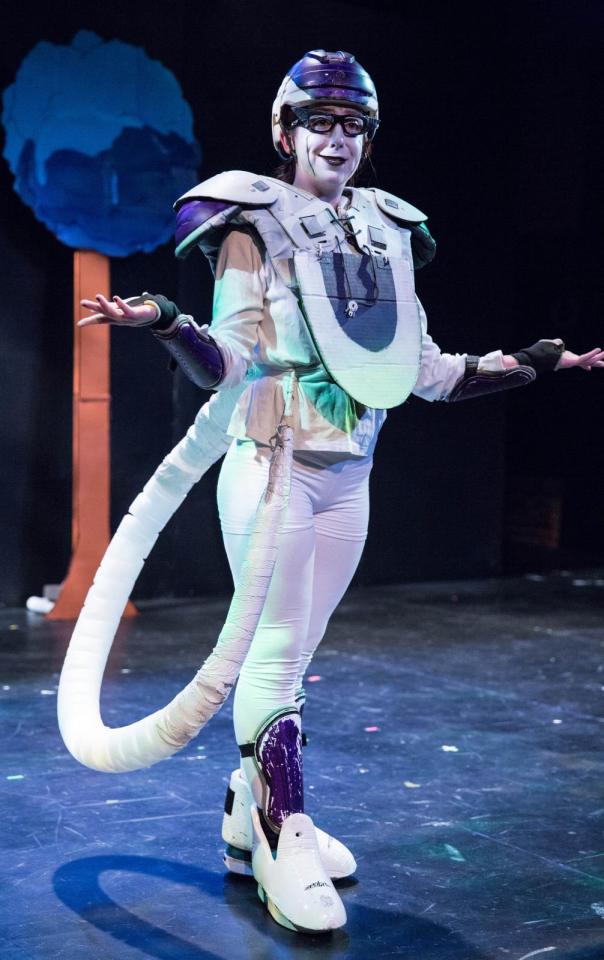
Photography by Ann B. Erickson. Vegeta is played by McKenzie Shappell. Freeza is played by Cayla Marie Wolpers. Costumes by Sarah Noel Simon.
#kamehamehamlet#theater#dbz#dragon ball#shakespeare#hamlet#waiting for godot#vegeta#freeza#goku#this is about as good a place as any to share that...#I only just realized after spending a day in Adobe Illustrator that I've just made the IKEA logo...
711 notes
·
View notes
Text

Weekend Lessons with daddy John PART 1
John, my mysterious neighbor, was a man shrouded in age and secrets. Though I never dared to inquire about his past, I estimated him to be around 65 years old. From the moment I moved in next door, he welcomed me with open arms and a warm smile. Despite our significant age difference - I was only 21 at the time - I found myself eagerly seeking out his company. John was a skilled handyman, passing on his knowledge of electricity, plumbing, and DIY projects to me with infinite patience. It may seem odd for a young adult like myself, but each week I looked forward more to spending an evening with John than going out for after-work drinks with my colleagues.
There was something about John that fascinated me - he wasn't particularly muscular or physically imposing, but there was a ruggedness to him that exuded masculinity. He embodied the classic image of a man's man - simple yet capable, full of practical knowledge that I had never learned before. But what captivated me most were his feet. Every Friday night, as we sat together watching a replay of a baseball game and sipping on cold beers, John would kick off his slippers and rest his large, mature feet on the coffee table in front of us.
It started innocently enough - just admiring the feet of a strong, masculine man. But as the weeks went by, my fascination turned into something else entirely. With each passing Friday night, it became harder and harder for me to resist the forbidden desires stirring inside of me. I tried to push them away, telling myself that it was wrong and dirty to feel this way towards someone much older than me.
But one fateful night, as I lay in bed alone with my thoughts, I gave in to my sinful desires and indulged in a forbidden act of self-pleasure while thinking about John's feet. The pleasure that consumed me was unlike anything I had ever experienced before, a heady mix of taboo and desire that left me both intoxicated and guilty.
From that night on, John's feet became an obsession for me. I couldn't resist stealing glances at them whenever we were together, imagining the feel of them against my lips and tongue. And each time I succumbed to these thoughts, the intensity of pleasure only grew stronger, driving me towards a dangerous edge that I could not escape from.
Despite my attempts to distance myself from these thoughts, they consumed me. I tried to distract myself with work, hobbies, and even dating other people, but nothing seemed to quell the burning desire I had for John's feet.
But one evening, I couldn't resist my insatiable desire… As we sat on the sofa, John's relaxed form radiating a familiar comfort, I chugged back another beer to calm my racing heart. Suddenly, his shoes were off and his toes were wriggling in front of me as he talked about the game. I couldn't help but feign interest in a coin that supposedly fell on the other side of the table. My hand brushed against his foot and I knelt down, pretending to search for the nonexistent coin in the thick carpet fibers as my face stealthily drew closer to his feet. The overpowering scent of masculinity hit me like a wave and my body reacted immediately, my pants stretching with the growing hardness between my legs. Every touch from his toes sent shivers through my body, pushing me deeper into a forbidden pleasure that consumed me completely.
My mind raced with a torrent of emotions and desires as I lingered there, my breath hot against John's coarse, calloused skin. I had never felt anything like this before - a mixture of exhilaration, shame, and unbridled lust coursing through my veins. I knew I was playing with fire, but I couldn't help myself.
A surge of shame and self-loathing washes over me as I realize the gravity of my actions. I pray that my arousal is not too obvious , ready to feign ignorance and confess to not finding the coin. But when I meet John's gaze, a new expression crosses his face - an excited smile, his hand resting on his visibly erect penis. Did he understand the true intention behind my gesture? And did the sight of my face so close to his feet elicit the same response in him as it did in me? My mind spins with confusion and desire, rendering me speechless and creating a tense silence that begs to be broken… I struggle to find the right words, while secretly yearning to ask him if he desires to see me throw myself at his feet as well…
It was finally John who broke the silence, saying these words: ''Are you sure you looked carefully? It would be a shame not to reject a glance." He looked me straight in the eyes, without leaving his mischievous smile, wiggling his toes… my eyes rested on those feet and the spark of excitement in the John's eyes twinkled brighter. It was at that moment that I realized that this was a formal invitation, and I was not going to wait another second to respond.
John's voice cut through the tense silence like a knife, his words dripping with challenge and mischievous thrill ''Did you even bother to look closely? Don't tell me you missed it." His gaze locked onto mine, a sly grin playing on his lips as he wiggled his toes in anticipation…my eyes couldn't help but trail down to those feet, and I saw the unmistakable glimmer of mischief in John's eyes. It hit me like a bolt of lightning - this wasn't just an invitation, it was a dare. And I refused to waste another second before responding, the fire of adrenaline coursing through my veins.
456 notes
·
View notes
Text




Land and Housing
As a result of decades of land confiscations and discriminatory land policies, Israeli authorities have hemmed in Palestinian towns and villages, while nurturing the growth and expansion of Jewish communities, many of which in practice exclude Palestinians. The majority of Palestinians in Israel live in these communities, while some live in “mixed cities” like Tel Aviv-Jaffa and Haifa.
Ninety-three percent of all land in Israel constitutes state land, directly controlled by the Israeli government. Israeli authorities confiscated much of this land, several million dunams, from Palestinians through several different legal instruments, as documented in a later chapter of this report. A government agency, the Israel Land Authority (ILA), manages and allocates state lands. Almost half the members of its governing body belong to the JNF, whose explicit mandate is to develop and lease land for Jews and not any other segment of the population. The fund owns 13 percent of Israel’s land, which the state is mandated to use “for the purpose of settling Jews.”
Israeli authorities have almost exclusively allocated state lands for the development and expansion of Jewish communities. Since 1948, the government has authorized the creation of more than 900 “Jewish localities” in Israel, but none for Palestinians except for a handful of government-planned townships and villages in the Negev and Galilee, created largely to concentrate previously displaced Bedouin communities. Less than 3 percent of all land in Israel falls under the jurisdiction of Palestinian municipalities, where the majority of Palestinian citizens live, according to a 2017 estimate by Israeli and Palestinian groups.
Even inside Palestinian towns and villages within Israel, Israeli authorities discriminatorily restrict the land available for residential growth. The authorities have zoned large sections of Palestinian towns and villages for “agricultural” use or as “green” areas, prohibited residential building in them, and built roads and other infrastructure projects that impede expansion. A 2003 Israeli government-commissioned report found that “many Arab towns and villages were surrounded by land designated for purposes such as security zones, Jewish regional councils, national parks and nature reserves or highways, which prevent or impede the possibility of their expansion in the future.”
While increasing focus in recent years on these issues has resulted in more state-approved residential development, they have done little to date to change the reality of hemmed-in Palestinian towns and villages. By contrast, in case studies documented by Human Rights Watch in each of Israel’s six districts, planning authorities provided sufficient land and zoning permissions to predominantly Jewish communities to facilitate their growth.
(continue reading)
#politics#palestine#gaza#isreal#israel is an apartheid state#illegal settlements#apartheid#displacement#israili apartheid#visualizing palestine#nakba#al nakba#🍉#🇵🇸
457 notes
·
View notes
Text
I actually find the topic of "Nomura's evolving art style as he takes on more and more responsibility at Square (and subsequently has less time to Do Stuff)" really fascinating.

Like, If you compare his art from the KH1-DDD era to his current day art, I think there's a noticable difference to his approach: how many steps there are in his art process, how he chooses to finish a piece, and the shift from a clean digital style to a more organic traditional one.
He used to use very clean, black lineart; bold colors; and more instances of defined/hard shading for that digital, almost cell-shaded or vector kinda look. Nowadays he goes for a more sketchy + watercolor style with pencil lineart, broad washes of faded color, and color shading that's a bit more blended and simplified in places (relying more on the pencil shading to create distinct shadows), with the hard edges more often reserved for scattered, bright highlights. (He's made art like this in the past eras too, such as the KH main menu arts which all have a watercolor quality to them, but the lineart was a bit more defined then and less sketchy, and thus slightly different from his current stuff.)
I think the Dark Road key art is a very good example of his current art style. The sketchy, almost brown lineart. The watercolor quality that emerges where two colors meet and overlap. A little desaturated and earthy. Color shading that's very broad, soft, and loose, with sharp highlights here and there.

Both styles have their merits (I personally love this sketchy era of his), but I think it's pretty likely that he adopted this as his "main" art style in order to adapt to time crunch. He doesn't need to do time-consuming lineart and precise shading anymore; he can use the original sketch as the lineart instead. Heck, he can fill in a bunch of the shading via pencil during this sketching phase to save even more time, and then can paint in a more watercolor-y kind of way that allows him to color in quicker, broader strokes.
And then there's the occasional art mistake that has become a bit more frequent in recent years, by my estimation. Which I imagine, again, is due to running out of time to notice/fix those mistakes. Things like Ephemer's arms being a bit too long in this UX art, the Kingdom Key being slightly off-model in this anniversary art, or the ears on this Mickey Mouse symbol being two different sizes on this Utada album art.



(Which isn't to say that he hasn't made art mistakes in the previous eras, for example he initially got the colors of Riku's shirt mixed up in the Re:CoM cover art before fixing it, but I still think the mistakes were a bit less frequent back then.)
And like, hey. I draw, too. Amatuerishly, but I do. I don't blame Nomura for possibly needing to change his approach to making art in order to meet deadlines, nor do I blame him for these little art mistakes that ended up falling through the cracks. I imagine he simply doesn't have the time anymore now that his job has shifted from (primarily) being a character designer/illustrator to (primarily) being a director of multiple, simultaneous projects. Or maybe I'm totally wrong about this and his art evolution had nothing to do with time crunch, who knows. I think his current art style is gorgeous either way!
Anyway, I just think this is an interesting example of someone taking their art and adapting it to a difficult and highly limiting situation, experimenting with new things and finding the means to still make art even when you have less time to do. Also a great example that professionals are human and will make mistakes even in professional products, and it's not the end of the world, it just happens. If you ever obsess over a mistake in your art...maybe take solace in knowing that it happens to everyone. Even people who have been in their field for a very long time.
98 notes
·
View notes
Text
okay sooo i made some sketches for a few of the sprites i'll be using, some of which i'm gonna show here, as well as thinking about the code edits i'll need to do for this project. i don't want to just redraw a shimeji to look like SQQ, i want him to act and move in character, so i have a whole bunch of edits to do

some of my notes:
i'm not yet sure how many sprites some animations will require so i'm not putting in a final number, or numbering which sprites will be used for what animation, but i'm going to throw out an estimate that the final sprite count will be about sixty-ish.
i mostly have all my animations already planned out. i know what i want them to look like and know how to do it, but there's a few i still need to think about, like one of the multiplying animations. i considered just getting rid of the one i have no ideas for, but i'll think on it some more. i'm open to suggestions too
i'm considering if i should code and draw in interactions with other shimejis already. it's a bit of a far off idea but i might make a Binghe or maybe even Liu Qingge or Shang Qinghua? who knows. anyway it'd be fun to make some interactions between them. i could even add a tutorial for adding more "romantic" interactions since i want to leave this area open for shippers. if i make it that is
"pet" - yes you can pat Shizun on the head. it makes him embarrased but he likes it.
i'd like to make this an incredibly intricate shimeji with a lot of animations but i'm worried about the performance. they may not be Chrome level RAM eaters, but they're not the lightest and i don't want to create something which people won't get to enjoy
i'm still considering where to host the files. thought about maybe hosting them on a patreon account (for free. the Shizun Distribution System does not demand payment for what it does) but i'm, again, open to suggestions
i'm making this for the Shimeji-ee DESKTOP SOFTWARE FOR WINDOWS. i've never used things like the shimeji chrome extension nor do i own any apple devices. i don't know how to work with these. HOWEVER, if there's someone who DOES know how to work on those, feel free to make versions compatibile with apple or with browsers, BUT only if those versions ARE DISTRIBUTED FOR FREE AND CREDIT ME AS THE CREATOR. i want as many people as possible to enjoy my shimejis
two long idles, one of which i'm showing the sketch for. in the notes i wrote down "looping" and "sound" - while it may be a project that i do not realize in the end, i thought it would be cute to make an animation where Shizun plays the guqin and add sound to it. there would have to be the option to toggle animation sounds, and another to loop that animation, but i thought it would be absolutely adorable to make a sort of music player out of that animation, allowing the user to add a downloaded copy of their playlist into the files. imagine - you're sitting at your computer, studying, working or filing your taxes or whatever, and Shizun's on your screen, doing his thing, providing background music for whatever it is you're doing. cute, no? but this feels like the sort of thing that might get annoying or make your computer turn into a jet engine from overworking. so, for now this is staying a concept. the animation will be present, that much i guarantee but all that other stuff might not show up
OKAY, SO. as you might have noticed i have three designs. i sorta changed them since i made the first post about this, because as it turns out my computer screen doesn't actually display bright colours all that well. might have to fiddle with the settings on it more. anyway this time i coloured looking at my tablet screen so they should be more accurate to what i wanted. i decided that my previous design didn't look like mint chocolate chip ice cream enough <3
so, i'd like you guys to tell me which design is your favourite! i have mixed feelings about design no. 3 because, while pretty, it's kinda too detailed. i just know i'd get sick of redrawing it so i might simplify it further for the finished product
here's the designs!

*slight correction: the eye colour is not final! i left the sketch in on those parts and forgot to actually draw the finished design for the eyes. i don't have the time to correct that at the moment, however. sorry! for a closer look at how the eyes might look like, see previous design
#svsss#scum villains self saving system#scum villain#shen qingqiu#shen yuan#chibi art#shimeji#my art#shizun shimeji#< new tag for sorting posts about this project
28 notes
·
View notes
Text


I wanted to save these for when I was done with the whole project but I have a feeling the next few entries will take a long time to make since each era has so many movies (Renaissance Era, Experimental Era and the Modern Era) and I got impatient with myself so I'm posting what's done so far.
So I decided to do a project where I draw films from each Disney era together. For those who don't know about Disney's animation eras, here's a good guide: https://www.bfi.org.uk/features/many-merry-eras-disney
The Renaissance Era had to be split into two drawings, I have a feeling the next two eras will have to be split into two or more drawings as well.
So! In the previous era Disney was in a very, very low place. However, that would all change in 1989 with the release of The Little Mermaid. The film was a massive success both critically and commercially, and it even won two Oscars (Best Original Song for "Under the Sea" and Best Original Score).
Their next film was actually the first sequel produced by Walt Disney Feature Animation. While the film got good reviews, it sadly didn't earn quite as much as The Little Mermaid (and to this day it's sadly the least-remembered from this era). It still has a notable role in Disney animation's history as it was their first animated film to use their new software system CAPS (Computer Animation Production System, a digital ink and paint system that would be used for all Renaissance films that came after).
Massive critical and commercial success would come back with Beauty and the Beast, so successful in fact that it was nominated for Best Picture (the Best Animated Film category didn't exist yet). It may not have won Best Picture but the fact that it was nominated in the first place is a huge deal. It did, however, win Best Original Score and Best Original Song (for the titular song "Beauty and the Beast").
Aladdin was the next film and would too go on to become a massive success, and yes, once again ended up scoring Oscars for Best Original Score and Best Original Song ("A Whole New World"). Now, I feel like I can't discuss Aladdin without bringing up Robin Williams. He's the most hilarious part of the film and is absolutely iconic as Genie, however, behind the scenes there was drama between him and Disney. You see, when Robin Williams was approached for the role, he agreed to do it on the condition that his name nor his image be used for marketing and that Genie takes up no more than 25% of the posters. Do you think Disney kept their promise? If you answered "no", then you are correct. And while Robin Williams's name wasn't used in advertisements for the film, his voice as Genie was still being used to advertise the movie and sell toys, without paying him additional money. Robin Williams was so upset over this (and rightfully so), that he refused to reprise his role for the direct-to-video sequel, however, this conflict has a happy ending because when CEO Jeffery Katzenberg (who was CEO when this fiasco happened) was replaced by Joe Roth, Roth organized a public apology to Robin Williams, leading to him even returning to voice Genie in another direct-to-video sequel for the film.
The next film was The Lion King, and of course, it was a massive success in every way, and you guessed it, also went on to win Oscars for Best Original Score and Best Original Song ("Can You Feel The Love Tonight").
Pocahontas came next, a very fictionalized film based on the real Pocahontas and John Smith (very, very, VERY loosely based on the real Pocahontas and John Smith, I should say). This film ended up getting mixed reviews, which is unsurprising given its historical inaccuracies. I try not to inject my own opinions into these posts too much but I just feel like adding that I loved the film as a kid, but now that I'm an adult and know the real history about Pocahontas (including the fact that she was estimated to be around 10, 11 or 12 when she met John Smith, who was in his twenties), I don't think I feel comfortable giving it a rewatch anytime soon. I will say, however, that it'll always be a beautifully animated film and "Just Around the Riverbend" and especially "Colors of the Wind" will always be great songs ("Colors of the Wind even won Best Original Song).
Interestingly, Jeffery Katzenberg hoped that Pocahontas would be the studio's next chance at getting nominated for Best Picture. On the other hand, he thought The Lion King (they were in development at the same time) was more "experimental", and so he considered Pocahontas the "A-team" project and The Lion King the "B-team" project. And as we all know by now, the opposite ended up happening in regards to which one was the bigger success.
The next film was The Hunchback of Notre Dame, and while it did have a lower box office success than Pocahontas, it was a bigger critical success. Hercules ended up having an even lower box office reception than Hunchback, but still received postive reviews. Mulan would go on to be another critical and commercial success, as did Tarzan (as well as an Oscar for Best Original Song for "You'll Be in My Heart").
One noticeable trend amongst the Renaissance Era was the music becoming more Broadway-inspired. This can largely be credited to Alan Menken and the late great Howard Ashman, who collaborated on Broadway together prior to collaborating at Disney, including creating the musical version of Little Shop of Horrors. The films they collaborated on for Disney was The Little Mermaid, Beauty and the Beast and Aladdin, in fact it was Howard Ashman who pitched the idea of making Aladdin into an animated musical to Disney.
Tragically, Howard Ashman was diagnosed with AIDS all the way back when he was working on The Little Mermaid, and when his disease got more severe by the time Beauty and the Beast was in production, Disney accommodated him by creating a production unit near his home so he could continue to work on the film while receiving treatment. Unfortunately, he died before the film was completed. Disney dedicated Beauty and the Beast to his memory, and even put this beautiful tribute in the end credits of the film: To our friend, Howard, who gave a mermaid her voice and a beast his soul, we will be forever grateful. Howard Ashman 1950-1991 (This always gets to me 🥺).
Also, I feel like I can't mention Howard Ashman without bringing this up, there's an excellent documentary about him on Disney Plus, simply called Howard that I definitely recommend. If you don't have Disney Plus but are still interested you can watch here. Back in 2023 it was revealed that Disney was going to remove a bunch of stuff from the platform to "cut costs" (🙄), and that included Howard, but of course that lead to extreme outcry, ESPECIALLY since it would be removed on the eve of Pride Month and Howard Ashman was a gay man, so that made the timing even worse. Thankfully the backlash worked and the documentary is still there to this day. I do still hope it gets a Blu-ray release eventually.
This era truly was a renaissance, absolutely one of the most magical periods in Disney's animation history.
Image size
#fan art#disney#disney renaissance#the little mermaid#the rescuers down under#beauty and the beast#aladdin#the lion king#pocahontas#the hunchback of notre dame#hercules#mulan#tarzan
20 notes
·
View notes
Text
How Maybe Happy Ending Became the Surprise Hit of the Broadway Season

DO ANDROIDS DREAM? The leads of Broadway's Maybe Happy Ending: Darren Criss, in Saint Laurent by Anthony Vaccarello, and Helen J Shen in Michael Kors Collection. Swarovski ring. Hair, Edward Lampley; makeup, Kuma. Photographed by Norman Jean Roy. Fashion Editor: Edward Bowleg III. Vogue, March 2025.
---------- Bringing the androids to life, as it were, are stage veteran Darren Criss and Broadway newcomer Helen J Shen. Backstage in his dressing room before curtain, Criss, 37, is bursting with chattiness, hazel eyes flashing and ring-laden fingers aflutter. He credits much of Maybe Happy Ending’s success to its extensive Korean incubation, comparing it to a nearly decade-long out-of-town tryout. “The level of nuance we focused on from the beginning is stuff that you don’t typically get until months in the weeds,” he says. “The trial and error has been happening long before us,” says Shen, who’s 24 but could easily pass for far younger, sitting serenely in a Winnie-the-Pooh sweatshirt. A classically trained pianist who competed internationally before studying theater performance at the University of Michigan (where Criss is also an alum), Shen has had a busy 2024, starring off-Broadway in The Lonely Few and Teeth. Meanwhile Criss is best known for the five seasons he spent as the endearingly charming, openly gay Blaine Anderson on Fox’s Glee. For this performance as an android with creakier movements than Shen’s, he drew on something he’d never put to use professionally: his college semester spent studying commedia dell’arte in Italy. “Stereotypical modern acting is about what you don’t see, and what I’m doing here is what you do see,” Criss says. His robot had been programmed to display unsubtle emotions: happy face, sad face, surprised face. These expressions and Criss’s faintly wooden physicality, inspired by the harlequin figure, “immediately make people more willing to connect to the show’s nonrealness,” he says. In rehearsals, he kept top of mind a note from Arden: “Just because it doesn’t feel real doesn’t make it not true.”

GROUP INTELLIGENCE Shen and Criss are joined in the cast by Dez Duron (center left) and Marcus Choi (center right). Costume design by Clint Ramos. Hair and wig design, Craig Franklin Miller; makeup, Suki Tsujimoto.
Underscoring that feeling of unreality is the shape-shifting set, involving a rotating turntable, proscenium LED tiles, and hologram-like projections. “The backstage mechanics are so unbelievably intricate,” Arden says. “My hope is that it’s working so well the audience doesn’t even notice.” The set was inspired by how we consume media on our phones; Arden estimates that the show spends more time in a vertical orientation than horizontal. Likewise, switching between sliding rooms on tracks emulates the effect of swiping on a personal device, and simple theatrical techniques like irising, created with black panels and neon, mimic how we pinch and zoom. Another influence was manga, which can tell big stories briskly, gracefully pushing readers from one image to another. The emphasis was on containing and focusing the audience’s point of view, Arden explains. “I wanted to take the audience on an adventure, leaving more to their imagination rather than trying to show everything.” Within those silently whizzing frames is a comforting, retro future-scape that the director compares to 2001: A Space Odyssey. “There’s this mix of cold futurism with warm sentimentality that’s also present in the score,” Arden says of the set. “You’re watching a classic Burt Bacharach musical, even though we’re driving a flying car.” The team has been floored by the rabid army of fans. Dubbed Fireflies, after a magical moment in the show, they range from repeat viewers dressing up as their favorite characters to those creating art inspired by HwaBoon, the emotional-support potted plant that many find the production’s low-key true star. (Arden calls her “a fabulous silent diva” who appeals to wallflowers in the audience.) A significant portion of those waiting by the stage door to meet the cast are Asian American, and while nearly all the actors in this production are also of Asian American descent, Shen shies from labeling the show narrowly. “It’s important to mark accomplishments, but whenever we put that pressure on to be a mouthpiece for any group of people that is multifaceted and contradictory and complicated, it’s going to fail.” Although actors of various races and ethnicities have previously portrayed the robots, almost every production has been set in Seoul. Yet Criss maintains “the show is as distinctly Korean as Romeo and Juliet is distinctly Italian...It’s where we set our scene, and some aspects of the show might spring from the culture.” (South Korea has the world’s highest density of robot workers.) “But it’s a story with universal themes: We all live, we all end, we all, hopefully, at some point, love or are loved.” The offbeat premise and ingenious staging prove that no algorithm can yet prescribe a hit Broadway musical. “As we enter into this world of AI, theater is one of the last completely human-made, -operated, -performed, and -received art forms,” Arden notes. “And that’s why we go to the theater—to learn something new about what it is to be alive.” How delightful that it’s possible in a musical about robots.
#darren criss#vogue#helen j shen#dez duron#marcus choi#maybe happy ending#maybe happy ending bway#press#jan 2025
45 notes
·
View notes
Text
The Role of a Construction Estimating Service in Urban Redevelopment and Adaptive Reuse
Introduction: Breathing New Life into Old Structures
Urban redevelopment and adaptive reuse projects are reshaping city landscapes by revitalizing aging infrastructure and underused buildings. These projects are often more complex than new construction due to the need to evaluate existing conditions, comply with evolving regulations, and preserve historical features. A construction estimating service plays a critical role in providing cost clarity, identifying potential risks, and ensuring project feasibility from the outset.
Unique Cost Challenges of Urban Redevelopment
Unlike greenfield projects, urban redevelopment involves variables that are often hidden until construction begins. These may include outdated building systems, structural deficiencies, hazardous materials, or non-compliant layouts. A construction estimating service must thoroughly assess these unknowns during the preconstruction phase, allocating contingencies and documenting assumptions based on site investigations and historical data.
Detailed Scope Analysis and Phasing
Urban redevelopment often requires phased construction to manage occupancy, utility disruptions, or zoning limitations. For adaptive reuse, construction may need to occur while parts of the building remain operational. A construction estimating service helps plan each phase with precision, ensuring that logistics, sequencing, and access constraints are reflected in labor costs, equipment rentals, and schedule impacts.
Dealing with Historical Preservation Requirements
When adaptive reuse involves heritage buildings, compliance with historical preservation standards can increase costs significantly. Specialized materials, traditional construction techniques, and additional permits may be required. Estimators must understand these requirements and consult with preservation experts to ensure budgets are both realistic and sensitive to the historical integrity of the project.
Estimating for Environmental Remediation
Urban sites often have legacy environmental issues such as asbestos, lead paint, or contaminated soil. A construction estimating service collaborates with environmental consultants to price remediation efforts. These costs can be substantial, especially in older industrial or commercial buildings being converted into modern residential or mixed-use developments.
Integration of Modern Systems into Old Structures
Adaptive reuse demands retrofitting new mechanical, electrical, plumbing (MEP), and fire protection systems into outdated frameworks. This often requires custom solutions, selective demolition, or rerouting infrastructure. Estimators must account for higher labor costs and the challenges of fitting standardized systems into non-standard conditions, which can impact timelines and budgets.
Navigating Incentives and Funding Requirements
Urban redevelopment projects are frequently supported by government incentives such as tax credits, grants, or low-interest financing. Many of these incentives have cost-reporting or compliance requirements. A construction estimating service helps developers meet these criteria by providing detailed cost breakdowns and documentation that align with funding rules, particularly in affordable housing or sustainability-focused projects.
Supporting Sustainability and Resilience Goals
Many adaptive reuse projects aim for sustainability certifications like LEED or WELL. A construction estimating service assesses the cost impact of energy-efficient upgrades, low-emission materials, and improved building envelopes. In urban redevelopment, resilience against floods, heat, or seismic risks may also factor into estimates, especially in cities with updated codes to address climate change.
Managing Stakeholder Expectations
Redevelopment projects often face heightened scrutiny from communities, planners, and investors. A construction estimating service brings transparency to the cost implications of design decisions and regulatory mandates. Clear, itemized estimates support stakeholder buy-in, enabling informed decision-making throughout the project's lifecycle.
Technology and Site Intelligence Tools
To improve accuracy, estimators use tools like laser scanning, point cloud data, and Building Information Modeling (BIM) to analyze existing conditions. These technologies help convert outdated or incomplete building documentation into reliable inputs for cost modeling, reducing the risk of major surprises during construction.
Conclusion: Turning Complexity into Opportunity
Urban redevelopment and adaptive reuse projects offer environmental, cultural, and economic benefits—but only if budgets are accurately planned. A construction estimating service serves as a strategic advisor, helping project teams navigate the complexity of existing structures, permitting hurdles, and historical constraints. With detailed cost insights and contingency planning, estimators transform redevelopment challenges into viable, forward-looking projects that reinvigorate cities and preserve architectural legacy.
#urban redevelopment estimating#adaptive reuse cost#estimating old buildings#redevelopment construction service#cost estimate historic building#building retrofit cost#asbestos removal cost#phased construction estimate#urban zoning cost#legacy building systems#code upgrade estimate#adaptive reuse estimator#BIM for reuse projects#historical preservation cost#affordable housing cost estimate#grant compliance estimate#contaminated site cost#seismic upgrade estimating#LEED retrofit estimate#utility rerouting cost#estimating with unknowns#stakeholder budget planning#community housing estimate#fire system retrofit cost#sustainability upgrade cost#resilience planning estimate#estimating with point cloud#downtown redevelopment cost#mixed-use conversion budget#city infill estimator
0 notes
Text
how much power does tech really use, compared to other shit?
my dash has been full of arguing about AI power consumption recently. so I decided to investigate a bit.
it's true, as the Ars Technica article argues, that AI is still only one fairly small part of the overall tech sector power consumption, potentially comparable to things like PC gaming. what's notable is how quickly it's grown in just a few years, and this is likely to be a limit to how much more it can scale.
I think it is reasonable to say that adding generative AI at large scale to systems that did not previously have generative AI (phones, Windows operating system etc.) will increase the energy cost. it's hard to estimate by how much. however, the bulk of AI energy use is in training, not querying. in some cases 'AI' might lead to less energy use, e.g. using an AI denoiser will reduce the energy needed to render an animated film.
the real problem being exposed is that most of us don't really have any intuition for how much energy is used for what. you can draw comparisons all sorts of ways. compare it to the total energy consumption of humanity and it may sound fairly niche; compare it to the energy used by a small country (I've seen Ireland as one example, which used about 170TWh in 2022) and it can sound huge.
but if we want to reduce the overall energy demand of our species (to slow our CO2 emissions in the short term, and accomodate the limitations of renewables in a hypothetical future), we should look at the full stack. how does AI, crypto and tech compare to other uses of energy?
here's how physicist David McKay broke down energy use per person in the UK way back in 2008 in Sustainable Energy Without The Hot Air, and his estimate of a viable renewable mix for the UK.

('Stuff' represents the embedded energy of manufactured goods not covered by the other boxes. 'Gadgets' represents the energy used by electronic devices including passive consumption by devices left on standby, and datacentres supporting them - I believe the embodied energy cost of building them falls under 'stuff' instead.)
today those numbers would probably look different - populations change, tech evolves, etc. etc., and this notably predates the massive rise in network infrastructure and computing tech that the Ars article describes. I'm sure someone's come up with a more up-to-date SEWTHA-style estimate of how energy consumption breaks down since then, but I don't have it to hand.
that said, the relative sizes of the blocks won't have changed that much. we still eat, heat our homes and fly about as much as ever; electric cars have become more popular but the fleet is still mostly petrol-powered. nothing has fundamentally changed in terms of the efficiency of most of this stuff. depending where you live, things might look a bit different - less energy on heating/cooling or more on cars for example.
how big a block would AI and crypto make on a chart like this?
per the IEA, crypto used 100-150TWh of electricity worldwide in 2022. in McKay's preferred unit of kWh/day/person, that would come to a worldwide average of just 0.04kWh/day/person. that is of course imagining that all eight billion of us use crypto, which is not true. if you looked at the total crypto-owning population, estimated to be 560 million in 2024, that comes to about 0.6kWh/day/crypto-owning person for cryptocurrency mining [2022/2024 data]. I'm sure that applies to a lot of people who just used crypto once to buy drugs or something, so the footprint of 'heavier' crypto users would be higher.
I'm actually a little surpised by this - I thought crypto was way worse. it's still orders of magnitude more demanding than other transaction systems but I'm rather relieved to see we haven't spent that much energy on the red queen race of cryptomining.
the projected energy use of AI is a bit more vague - depending on your estimate it could be higher or lower - but it would be a similar order of magnitude (around 100TWh).
SEWTHA calculated that in 2007, data centres in the USA added up to 0.4kWh/day/person. the ars article shows worldwide total data centre energy use increasing by a factor of about 7 since then; the world population has increased from just under 7 billion to nearly 8 billion. so the amount per person is probably about a sixfold increase to around 2.4kWh/day/person for data centres in the USA [extrapolated estimate based on 2007 data] - for Americans, anyway.
however, this is complicated because the proportion of people using network infrastructure worldwide has probably grown a lot since 2007, so a lot of that data centre expansion might be taking place outside the States.
as an alternative calculation, the IEA reports that in 2022, data centres accounted for 240-340 TWh, and transmitting data across the network, 260-360 TWh; in total 500-700TWh. averaged across the whole world, that comes to just 0.2 kWh/day/person for data centres and network infrastructure worldwide [2022 data] - though it probably breaks down very unequally across countries, which might account for the huge discrepancy in our estimates here! e.g. if you live in a country with fast, reliable internet where you can easily stream 4k video, you will probably account for much higher internet traffic than someone in a country where most people connect to the internet using phones over data.
overall, however we calculate it, it's still pretty small compared to the rest of the stack. AI is growing fast but worldwide energy use is around 180,000 TWh. humans use a lot of fucking energy. of course, reducing this is a multi-front battle, so we can still definitely stand to gain in tech. it's just not the main front here.
instead, the four biggest blocks by far are transportation, heating/cooling and manufacturing. if we want to make a real dent we'd need to collectively travel by car and plane a lot less, insulate our houses better, and reduce the turnover of material objects.
126 notes
·
View notes
Text
Time Blocking
Time-blocking: scheduling out EVERY PART of your day
What to time-block
Inflexible events (lectures, work shifts, appointments)
Routines (getting ready for school/work, getting ready to go to sleep, etc.)
Tasks (studying, homework, projects, chores, etc.)
How to time-block:
Get a calendar (preferably digital so it’s easily changeable.) I use a mix of Google Calendar and iCalendar.
Make separate calendars for separate parts of your life (personal, work, school.) I personally separate my classes as well because it’s easier.
Schedule all inflexible events first. Why? To see how you can balance and schedule your day around those times.
Schedule the time it takes to get to school/work. It helps you see how much time you have to do stuff that doesn’t require you to commute. (You can also study while commuting, but it can be harder if you have multiple transfers, or get easily car-sick. Also, public transit can be dangerous, so be careful.)
Schedule the tasks you need to do. Homework, studying, laundry, cleaning. Estimate the time you think it takes to do those things. If you have ADHD, you should probably multiply that time to 2 (or 3), because you will most likely get distracted and not finish it in time (instead of 15 minutes, it’s probably 30 minutes.)
All short individual tasks like taking out garbage and folding laundry, you should group those short tasks together in one block and just make a to-do list.
#studyblr#study tips#study tricks#study advice#school tips#study hacks#school life#student life#student#university#studyspo#study motivation#study blog
256 notes
·
View notes
Text
How to Survive Being Online
There was an article going around a few weeks back that listed dozens of good things that happened in 2024 globally. The site linked to a weekly roundup newsletter called "Fix the News" that I subscribed to, and it's SO wonderful. It's free, but there's also a paid version. It links its sources as well.
As an American who has been spiraling into hopelessness, it puts into perspective that a lot of progress is still happening worldwide and it's helped to shift my perspective from being so Western-centric.
This week's newsletter included this advice from Mike Monteiro (cw for some ableist language; bolding is mine)
"The only way to defeat a narcissistic sociopath is to starve them. Protect yourself from their bullshit, of course, but move away from it. Let them have their stage, but refuse to be their audience. This isn’t easy. It’s especially difficult because capitalism is an attention economy. The New York Times and The Washington Post love a narcissistic sociopath because they generate clicks and clicks sell ads. Social media loves a narcissistic sociopath for the same reason, but it’s even worse. On social media, we’re the ones carrying their water. Trump says something that he knows will get him attention (i.e. renaming the Gulf of Mexico) and not only does it fire up hundreds of media outlets, who now divert attention to this idiocy, but it also fires up tons of people like me and you, who end up reposting his garbage. Some of us because we feel like we’re media outlets (we’re not), some of us because we’re freaked out and freaking other people out justifies our own freak-out, and some of us because we were once bitten by a narcissistic sociopath under a full moon and we want to generate some of those sweet sweet likes in our direction. The first four years of Donald Trump was a continuous panic attack. I’m not going through that again. You don’t have to either. They’re on stage, but you don’t have to be their audience."
A few positives in this week's newsletter: Wage inequality has declined in two-thirds of countries since 2000 A new report from the International Labour Organisation has revealed that, since the early 2000s, global wage inequality has fallen at an average rate ranging from 0.5% to 1.7% annually, with the most significant decreases occurring in LMICs. Global real average wage growth has started to surpass inflation, with projections reaching 2.7% growth for 2024, the highest increase in over 15 years. (source)
The fastest energy transition in history continues Solar and wind are being installed at a rate five times faster than all other new electricity sources—including gas, hydro and nuclear—combined. At these growth rates, energy think tank, Ember estimates that by 2032, solar and wind generation will surpass the combined output of coal and gas. Step by step, the outlook for the world’s energy mix is getting brighter. (source)
Aid begins pouring into Gaza Over 2,400 aid trucks have entered the Gaza Strip since the cessation of hostilities was announced on Sunday. The truce requires at least 600 truckloads of aid to be allowed into Gaza every day of the initial six-week ceasefire. “This is a moment of tremendous hope — fragile, yet vital,” says Tom Fletcher, the United Nations undersecretary general for humanitarian affairs. (source)
Anyway, I highly recommend taking a look. This has seriously helped my mental health, and I think we could all use a little respite.
23 notes
·
View notes
Note
dear mediocre bird of prey, would you share resources to learn about nasa’s functioning and fucking up? cursory google search didn’t turn up all that much


although the real tragedy isn't that they lost two shuttles it's that they built them in the first place; Maciej Cegłowski wrote the best summary of the shuttle program back in 2005:
There is no satisfactory answer for why all this commotion must take place in orbit. To the uneducated mind, it would seem we could accomplish our current manned space flight objectives more easily by not launching any astronauts into space at all - leaving the Shuttle and ISS on the ground would result in massive savings without the slighest impact on basic science, while also increasing mission safety by many orders of magnitude. It might even bring mission costs within the original 1970's estimates, and allow us to continue the Shuttle program well into the middle of the century.
and he just posted a summary of where he thinks the Artemis program is going in 2024:
You don’t have to be a rocket scientist to wonder what’s going on here. If we can put a man on the moon, then why can't we just go do it again? The moon hasn’t changed since the 1960’s, while every technology we used to get there has seen staggering advances. It took NASA eight years to go from nothing to a moon landing at the dawn of the Space Age. But today, twenty years and $93 billion after the space agency announced our return to the moon, the goal seems as far out of reach as ever.
Articles about Artemis often give the program’s tangled backstory. But I want to talk about Artemis as a technical design, because there’s just so much to drink in. While NASA is no stranger to complex mission architectures, Artemis goes beyond complex to the just plain incoherent. None of the puzzle pieces seem to come from the same box. Half the program requires breakthrough technologies that make the other half unnecessary. The rocket and spacecraft NASA spent two decades building can’t even reach the moon. And for reasons no one understands, there’s a new space station in the mix.
In the past, whatever oddball project NASA came up with, we at least knew they could build the hardware. But Artemis calls the agency’s competence as an engineering organization into question. For the first time since the early 1960's, it's unclear whether the US space agency is even capable of putting astronauts on the moon.
36 notes
·
View notes